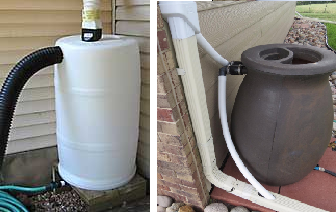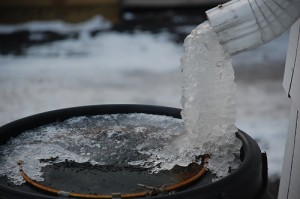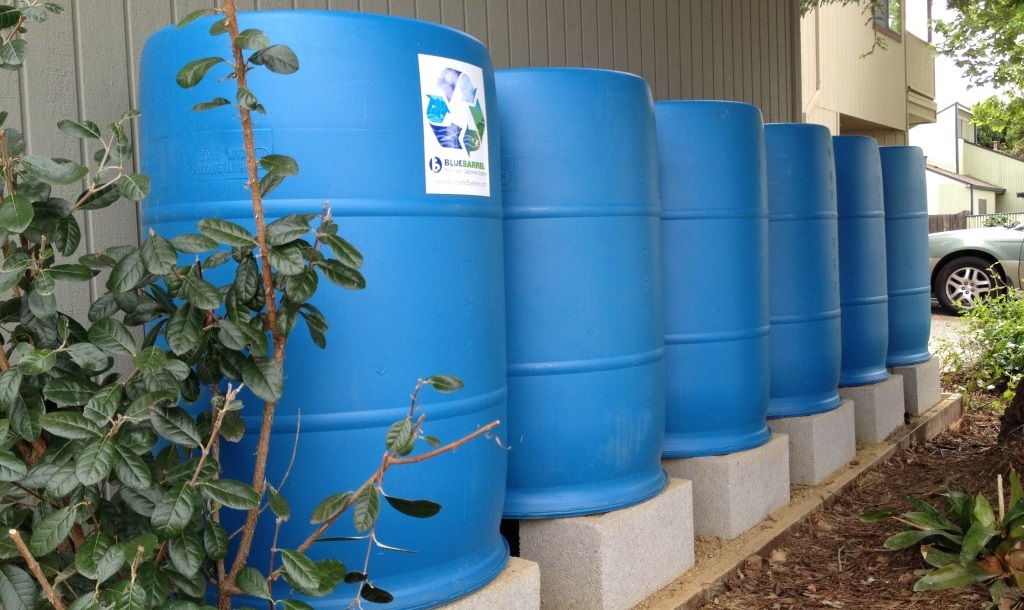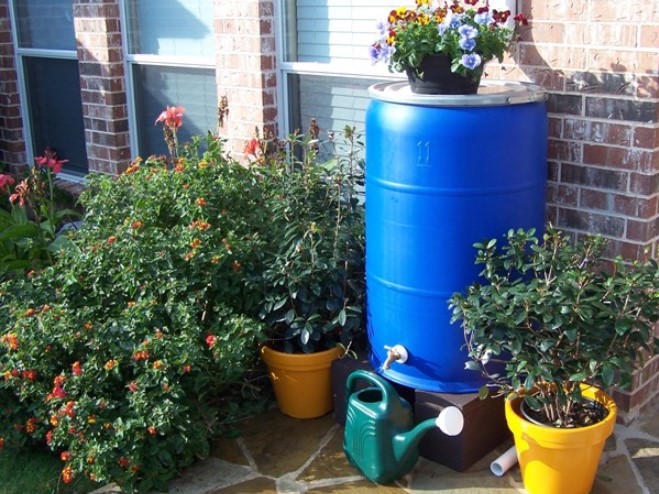
The City of Oberlin is located in the Plum Creek/Black River Watershed, which flows into Lake Erie. Stormwater flows across our lawns and driveways, through our streets, into our storm sewers, into Plum Creek and ultimately to Lake Erie. Heavy storms can lead to flooding and soil erosion, as all of the water tries to make this journey at the same time. Capturing stormwater in rain barrels, cisterns, or other green infrastructure helps reduce the flow of water happening at one time.
To promote the use of green infrastructure to improve the health of our watershed, the City of Oberlin is offering a voluntary incentive program for the installation of rain barrels on residential properties. The program currently offers one (1) not-to-exceed $50 rebate for one (1) rain barrel per property.
CLICK HERE TO DOWNLOAD THE REBATE APPLICATION
Residents are encouraged to find a size and model of rain barrel that works for them, functionally and aesthetically.
Rain barrels may be found at local home improvement, farm supply, or similarly styled stores. There are also companies/websites that specialize in selling different types of rain barrels. The City of Oberlin does not recommend a specific style of rain barrel.
If there are questions, call the Stormwater Coordinator at 440-776-4871
Things to Keep in Mind When Choosing a Rain Barrel
Rain barrels typically are installed via some kind of connection to a downspout. While non-connected water storage containers can and do exist (where the rain falls from the sky directly into a container), these collection systems are inefficient at gathering water and do not protect against mosquitos; therefore the City of Oberlin recommends against this method of collection.
For reviews and a comparison of several different types of downspout connections, check out this (unaffiliated) review site. Please note that diverters are not current included for reimbursement as part of the rebate program.


However water from the downspout enters the rain barrel, the rain barrel must be sealed so that mosquitoes and other insects may not freely access the water and use it as a breeding ground.
For closed connections (tubes and direct connections between the downspout and barrel), if there are open bung holes in the top of the barrel, these should be plugged with the proper sized plug or threaded bung caps.
Open systems that have a downspout's flow directed into the top of the rain barrel should be covered with mesh or a screen. The mesh or screen cover will need to be glued or otherwise sealed tight so that it cannot be accidentally disturbed, allowing direct access to the stored water.
In addition to a downspout connection, rain barrels need an overflow or outlet area. Many direct connect downspout diverters allow water to continue flowing down and out the downspout once the barrel is full. Other kits and open rain barrels may require an overflow tube to be installed separately on the rain barrel.
The overflow should be similar in size to the inlet, to allow water to flow easily through the system.

Rain barrels are on average 40 to 55 gallons in size, although they can range from 15 to several hundred gallons. Price varies based on size and material, as does the weight of the rain barrel.
When placed near the downspout, it is recommended that rain barrels be set on a platform of some kind (constructed out of wood, brick, concrete block, or other sturdy material) so that the spigot at the bottom of the rain barrel is easily accessible. Make sure that the base that the rain barrel is set on can withstand the weight of the full rain barrel. A gallon of water weighs about 8 1/3 pounds, so a full 55 gallon rain barrel can weigh over 450 pounds!


Once your rain barrel is installed, remember to empty it between storms!
The simplest way to use harvested water is to fill a watering can and hand water plants. Hoses may also be hooked up to the spigot, but it is important to remember that a rain barrel is a gravity-fed watering system. The water must flow downhill, which may require creative placement of the hose or sprinkler in relation to the barrel. (More precisely, in relation to the water level inside the barrel.)
What Maintenance Does A Rain Barrel Need?
Spring/April:
- Depending on how you winterized your rain barrel from last year, you may need to reconnect the rain barrel to the diverter, or otherwise check to make sure the rain barrel is connected to its water source and is sound for holding water this season.
- Check the spigot and connector tubes for leaks. If necessary, consider sealing these areas with fresh waterproofing caulk. (If this is done, do it while the rain barrel is still dry.)

Summer:
- Clean off any debris that accumulates on top of a mesh or screen top.
- If algae starts growing inside the barrel, clean it thoroughly (use a long handled brush if able) with a vinegar and water mix or a light bleach and water solution. Rinse and drain well and let it air dry before reuse.
- Periodically check all tubes and connections to make sure there aren't any leaks.
- If the spigot is connected to a hose, check to make sure the threads on the spigot are clean, the hose isn't clogged, and everything is working as expected.

Autumn/October:
- Disconnect/remove the rain barrel from the downspout.
- Drain and clean the rain barrel. Make sure to let it air dry. (See Summer list for details)
- If desired, store the rain barrel inside, or upside down with the spigot open to prevent any water from collecting and freezing inside.
- Ultimately, make sure that water cannot collect and freeze inside the rain barrel (potentially cracking it) during the winter.


How Much Water Can Be Harvested?
A number of factors affect how much stormwater a property can harvest in a year - including frequency of storms, intensity of storms, area of roof collecting stormwater, holding capacity of rain barrel/containment system, number of rain barrels, and how well the rain barrels are emptied between storms.

Volume of Rainfall and Roof Dimensions
1.0 inch of rain on 1 square foot of surface equals 0.623 gallons of water that can be collected. So, to calculate the amount of rain that can be harvested from a roof, one needs to do a little math.
It is rare for an entire roof to be connected to a single downspout, so the area of roof that feeds a downspout (the downspout the rain barrel is connected to) needs to be calculated.
Roof Area
Think back to geometry: Area = Length x Width. If a section of roof is 20 feet long and 10 feet wide, the area of that section is (20x10=) 200 square feet.
Now that the area of the roof connected to a downspout is known, multiply the square feet of roof by the amount of rain that falls to get gallons of water collected!


Northeast Ohio Weather Patterns
In Northeast Ohio, an average summer month will have 3.0 inches of rain1.
Those 3.0 inches of rain mean that up to 1.87 gallons of water can be collected per square foot of roof (3.0 inches rain x 0.623 gallons per inch per square foot = 1.87 gallons per square foot). A 200 square foot roof can then collect up to 374 gallons per summer month (1.87 gallons per square foot x 200 square feet = 374 gallons).
For that 200 square foot roof example, a storm precipitating only 0.28 inches of rain will fill a 55 gallon rain barrel. So, a single storm can easily provide more water than can be collected by one rain barrel. Hooking up several rain barrels in a connected chain to a downspout is one way to maximize rain collection from each storm - but this can be an involved and complex process. It also isn't necessary to enjoy rain harvesting.
Since a rain barrel can only collect as much water as there is empty space to be filled, the most important thing is to keep an eye on the weather forecast and make sure to use the previously collected water before a new storm arrives!

Other Resources to Explore:
Lorain County Soil and Water Conservation District, "Rain Barrels"
Cuyahoga County Soil and Water Conservation District, "Introduction to Rain Barrels" (Video)
Rain Barrel Painting Guide (Click to Download PDF)
.
